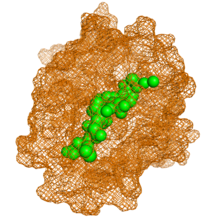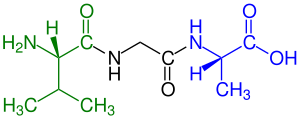Peptide

Peptides are short chains of amino acids linked by peptide bonds.[1][2] A polypeptide is a longer, continuous, unbranched peptide chain.[3] Polypeptides that have a molecular mass of 10,000 Da or more are called proteins.[4] Chains of fewer than twenty amino acids are called oligopeptides, and include dipeptides, tripeptides, and tetrapeptides.
Peptides fall under the broad chemical classes of biological polymers and oligomers, alongside nucleic acids, oligosaccharides, polysaccharides, and others.
Proteins consist of one or more polypeptides arranged in a biologically functional way, often bound to
Amino acids that have been incorporated into peptides are termed residues. A water molecule is released during formation of each amide bond.[6] All peptides except cyclic peptides have an N-terminal (amine group) and C-terminal (carboxyl group) residue at the end of the peptide (as shown for the tetrapeptide in the image).
Classification
There are numerous types of peptides that have been classified according to their sources and functions. According to the Handbook of Biologically Active Peptides, some groups of peptides include plant peptides, bacterial/
Some ribosomal peptides are subject to proteolysis. These function, typically in higher organisms, as hormones and signaling molecules. Some microbes produce peptides as antibiotics, such as microcins and bacteriocins.[8]
Peptides frequently have
These complexes are often laid out in a similar fashion, and they can contain many different modules to perform a diverse set of chemical manipulations on the developing product.
Peptones are derived from animal milk or meat digested by proteolysis.[15] In addition to containing small peptides, the resulting material includes fats, metals, salts, vitamins, and many other biological compounds. Peptones are used in nutrient media for growing bacteria and fungi.[16]
Peptide fragments refer to fragments of proteins that are used to identify or quantify the source protein.[17] Often these are the products of enzymatic degradation performed in the laboratory on a controlled sample, but can also be forensic or paleontological samples that have been degraded by natural effects.[18][19]
Chemical synthesis
Protein-peptide interactions

Peptides can perform interactions with proteins and other macromolecules. They are responsible for numerous important functions in human cells, such as cell signaling, and act as immune modulators.[21] Indeed, studies have reported that 15-40% of all protein-protein interactions in human cells are mediated by peptides.[22] Additionally, it is estimated that at least 10% of the pharmaceutical market is based on peptide products.[21]
Example families
The peptide families in this section are ribosomal peptides, usually with hormonal activity. All of these peptides are synthesized by cells as longer "propeptides" or "proproteins" and truncated prior to exiting the cell. They are released into the bloodstream where they perform their signaling functions.
Antimicrobial peptides
Tachykinin peptides
Vasoactive intestinal peptides
- VIP (Vasoactive Intestinal Peptide; PHM27)
- PACAPPituitary Adenylate Cyclase Activating Peptide
- Peptide PHI 27 (Peptide Histidine Isoleucine 27)
- GHRH1-24 (Growth Hormone Releasing Hormone 1-24)
- Glucagon
- Secretin
Opioid peptides
- Proopiomelanocortin (POMC) peptides
- Enkephalin pentapeptides
- Prodynorphin peptides
Calcitonin peptides
Self-assembling peptides
- Aromatic short peptides[23][24]
- Biomimetic peptides[25]
- Peptide amphiphiles[26][27][28][29]
- Peptide dendrimers[30]
Other peptides
- B-type Natriuretic Peptide (BNP)- produced in the myocardium and useful in medical diagnosis
- Lactotripeptides - Lactotripeptides might reduce blood pressure,[31][32][33] although the evidence is mixed.[34]
- Peptidic components from traditional Chinese medicine Colla Corii Asini in hematopoiesis.[35]
- Jelleine - produced from royal jelly of honey bees.
Terminology
Length
Several terms related to peptides have no strict length definitions, and there is often overlap in their usage:
- A polypeptide is a single linear chain of many amino acids (any length), held together by amide bonds.
- A protein consists of one or more polypeptides (more than about 50 amino acids long).
- An oligopeptide consists of only a few amino acids (between two and twenty).
Number of amino acids

green marked amino end (L-valine) and
blue marked carboxyl end (L-alanine)
Peptides and proteins are often described by the number of amino acids in their chain, e.g. a protein with 158 amino acids may be described as a "158 amino-acid-long protein". Peptides of specific shorter lengths are named using IUPAC numerical multiplier prefixes:
- A monopeptide has one amino acid.
- A dipeptide has two amino acids.
- A tripeptide has three amino acids.
- A tetrapeptide has four amino acids.
- A pentapeptide has five amino acids. (e.g., enkephalin).
- A hexapeptide has six amino acids. (e.g., angiotensin IV).
- A heptapeptide has seven amino acids. (e.g., spinorphin).
- An octapeptide has eight amino acids (e.g., angiotensin II).
- A nonapeptide has nine amino acids (e.g., oxytocin).
- A decapeptide has ten amino acids (e.g., gonadotropin-releasing hormone and angiotensin I).
- A undecapeptide has eleven amino acids (e.g., substance P).
The same words are also used to describe a group of residues in a larger polypeptide (e.g.,
Function
- A neuropeptide is a peptide that is active in association with neural tissue.
- A lipopeptide is a peptide that has a lipid connected to it, and pepducins are lipopeptides that interact with GPCRs.
- A peptide hormone is a peptide that acts as a hormone.
- A proteose is a mixture of peptides produced by the hydrolysis of proteins. The term is somewhat archaic.
- A peptidergic agent (or drug) is a chemical which functions to directly modulate the peptide systems in the body or brain. An example is opioidergics, which are neuropeptidergics.
- A cell-penetrating peptide is a peptide able to penetrate the cell membrane.
See also
- Acetyl hexapeptide-3
- Beefy meaty peptide
- Collagen hybridizing peptide, a short peptide that can bind to denatured collagen in tissues
- Bis-peptide
- CLE peptide
- D-peptide
- Epidermal growth factor
- Journal of Peptide Science
- Lactotripeptides
- Micropeptide
- Multifunctional peptide
- Neuropeptide
- Palmitoyl pentapeptide-4
- Pancreatic hormone
- peptide spectral library
- Peptide synthesis
- Peptidomimetics (such as peptoids and β-peptides) to peptides, but with different properties.
- Protein tag, describing addition of peptide sequences to enable protein isolation or detection
- Replikins
- Ribosome
- Translation (biology)
References
- ISBN 978-1-119-69817-3.
- ISBN 0-7167-4339-6.
- ISBN 978-0-07-337825-1.
- .
- S2CID 206548864.
- .
- ISBN 978-0-12-385095-9.
- PMID 17653356.
- S2CID 10924338.
- S2CID 3015474.
- PMID 6137189.
- PMID 15498872.
- PMID 15487945.
- PMID 11378961.
- ^ "UsvPeptides- USVPeptides is a leading pharmaceutical company in India". USVPeptides.
- PMID 775944.
- PMID 17587460.
- PMID 16350956.
- PMID 10572976.
- ^ "Propedia v2.3 - Peptide-Protein Interactions Database". bioinfo.dcc.ufmg.br. Retrieved 2023-03-28.
- ^ PMID 33388027.
- PMID 16279839.
- PMID 29146781.
- PMID 27115033.
- PMID 21309606.
- .
- PMID 27461453.
- PMID 27550381.
- PMID 21675796.
- S2CID 199519310.
- PMID 19061526.
- PMID 18562172.
- PMID 19109662.
- PMID 18086944.
- PMID 26911525.
